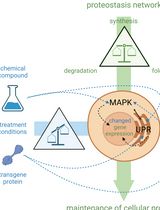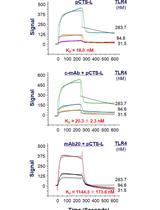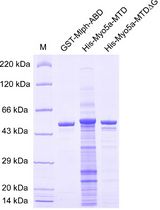- EN - English
- CN - 中文
Measurement of Protein-Protein Interactions through Microscale Thermophoresis (MST)
利用微量热泳动仪 (MST)检测蛋白间相互作用
发布: 2020年04月05日第10卷第7期 DOI: 10.21769/BioProtoc.3574 浏览次数: 8286
评审: Joana Alexandra Costa ReisMarc-Antoine SaniXiaoxiao Cheng

相关实验方案

Cell-Sonar:通过特定蛋白标志物表达变化追踪目标蛋白的简便低成本方法
Sabrina Brockmöller [...] Simone Rothmiller
2025年02月05日 1265 阅读
Abstract
The binding interactions of PD-1 and PD-L1 have been studied by surface plasmon resonance (SPR) and isothermal titration calorimetry (ITC) over the past few years, but these investigations resulted in controversy regarding the values of the dissociation constant (Kd) (Freeman et al., 2000). MST is a powerful new method for the quantitative analysis of protein-protein interactions (PPIs) with low sample consumption. The technique is based on the movement of molecules along microscopic temperature gradients, and it detects changes in their hydration shell, charge or size. One binding partner is fluorescently labeled, while the other binding partner remains label-free. We used a protocol that allows the determination of the binding affinity by MST without purification of the target protein from the cell lysate. The application of this MST method to PD-1-eGFP and PD-L1-eGFP expressed in CHO-K1 cells allowed us, for the first time, to determine the affinity of the complex formed between PD-1 and its ligand PD-L1 during tumor escape. The protocol has a variety of potential applications for studying the interactions of proteins with small molecules.
Keywords: Microscale thermophoresis (微量热泳动仪)Background
The identification of compounds that might be able to modulate the affinity of the complex formed between PD-1 and PD-L1 represents a major advance in the development of new treatments targeting immune escape for oncology. This protocol involves the overexpression of an eGFP fusion protein, which is then extracted from the cell lysate, enabling the determination of the affinity constant between PD-1 and PD-L1 without any purification steps. Thus, the development of this protocol required the production of eGFP fusion proteins. This protocol was designed to quantitatively accelerate the characterization of protein interactions by avoiding tedious purification steps. This protocol could also be used to perform high-throughput screening with PD-1/PD-L1 inhibitors to evaluate the ability of these recently developed molecules to modulate the affinity of the PD-1 protein for its ligand, as the small-molecule “blocking pathway” represents a major challenge for the development of new strategies targeting immune escape for oncology.
Microscale thermophoresis (MST) is a biophysical technique that measures the strength of the interaction between two molecules by detecting variations in the fluorescence signal as a result of an IR laser-induced temperature change. The range of the variation in the fluorescence signal correlates with the binding of a ligand to the fluorescent target. Overall, MST is based on the movement of a fluorescent molecule within a temperature gradient. MST also has broad applications at concentrations ranging from picomolar to molar and involves very little sample consumption, requiring only a few microliters; in addition, no immobilization of the protein of interest is required. You can either add a fluorescent tag to your protein of interest or exploit the intrinsic fluorescence of the target. In any case, one binding partner is fluorescent, while the other binding partner remains label-free. MST has also been used to characterize protein-small molecule interactions such as those involving aptamers (Entzian and Schubert, 2016) and PD-L1 inhibitors by BMS (Ganesan et al., 2019) or for high-throughput screening to identify hits (Rainard et al., 2018). Here, we describe a protocol using MST to determine the binding affinity of the PD-1/PD-L1 complex, which is involved in tumor escape processes, without purification of the target protein from cell lysates (Khavrutskii et al., 2013). This method requires the overexpression of fluorescent proteins in CHO-K1 cells and describes the optimal conditions for determining the dissociation constant. The protocol has a variety of potential applications for studying the interactions of these proteins with small molecules and demonstrates that MST is a valuable method for studying the PD-1/PD-L1 pathway.
Materials and Reagents
- T75 flasks
- PCR tubes (20 µl; NanoTemper Technologies GmbH, Munich, Germany)
- Thermo ClipTip tip 300 volume 30-300 µl (Dominique DUTSCHER SAS, catalog number: 228370 )
- Thermo ClipTip tip 12.5 volume 0.5-12.5 µl (Dominique DUTSCHER SAS, catalog number: 228606 )
- MonolithTM NT.115 Series, Premium Capillaries (NanoTemper Technologies GmbH, catalog number: MO-K025–200 Count )
- CHO-K1 cells (ATCC, catalog number: CCL-61 ), -80 °C
- Mix & Go competent E. coli cells (Zymo Research, catalog number: T3009 )
- GFP dosage kit (Abnova, catalog number: KA0911 ), 4 °C
- pcDNA3.1 plasmid (Life Technologies, catalog number: V79520 ), -20 °C
- pcDNA3.1 Hygro plasmid (Life Technologies, catalog number: V870-20 ), -20 °C
- Plasmid hPD-L1-eGFP (GeneCopoeia, CS-GS402 L-M10/pReceiver-M10 ), -20 °C
- Plasmid with mutant variant of hPD-L1-eGFP (GeneCopoeia, CS-GS406 L-M10/pReceiver-M10 ), 20 °C
- GeneticinTM Selective Antibiotic (Thermo Fisher Scientific, catalog number: 10131035 )
- DNA polymerase (CliniSciences Kapa HiFi HotStart Readymix), -20 °C
- PCR clean-up gel extraction kit (Machery-Nagel, catalog number: 740609.250 ), RT-qPCR
- Mini Plasmid Prep Kit (Machery-Nagel, catalog number: 740588.250 )
- Cell Line Nucleofector® Kit T (Lonza, catalog number: VVCA-1002 )
- HaltTM Protease Inhibitor Cocktail, EDTA-Free (Thermo Fisher Scientific, catalog number: 78439 )
- RIPA Lysis and Extraction Buffer (Thermo Fisher Scientific, catalog number: 89900 )
- Trypsin-EDTA solution (Merck, catalog number: T4049-100 ML )
- Complete medium: Ham's F-12K (Kaighn's) Medium (Thermo Fisher Scientific, catalog number: 21127 )
- 1% penicillin-streptomycin (10,000 U/ml) (Thermo Fisher Scientific, catalog number: 15140122 )
- 10% Foetal Bovine Serum (FBS) South America (Biosera, catalog number: FB-1001 )
- PBS (1x) (Thermo Fisher Scientific, catalog number: 12559069 )
- PBS-T (1x), phosphate-buffered saline with Tween-20 (NanoTemper Technologies GmbH, Munich, Germany)
- Recombinant human PD-L1/B7-H1 (Biotechne, catalog number: 156-B7-100 )
- (Optional) DMSO
- (Optional) Glycerol
Equipment
- Thermo Scientific ClipTip Pipettes (ClipTipTM 300 µl and ClipTipTM 12.5 µl)
- NanoTemper® Monolith NT.115 with blue/red filters (NanoTemper Technologies GmbH, Munich, Germany)
- NucleofectorTM 2b device (Lonza, Basel, Switzerland)
- Centrifuge (Sigma Labourzentrifugen GmbH, model: SIGMA 3-16KL )
- Flow Cytometer (BD FACS Aria)
- Inverted laboratory microscope with LED illumination (Leica Microsystems)
Software
- NanoTemper® (MO. Control) (https://nanotempertech.com/monolith-mo-control-software)
- NanoTemper® (MO. AffinityAnalysis(x86)) (https://nanotempertech.com/monolith-mo-control-software/)
Procedure
文章信息
版权信息
© 2020 The Authors; exclusive licensee Bio-protocol LLC.
如何引用
Romain, M., Thiroux, B., Tardy, M., Quesnel, B. and Thuru, X. (2020). Measurement of Protein-Protein Interactions through Microscale Thermophoresis (MST). Bio-protocol 10(7): e3574. DOI: 10.21769/BioProtoc.3574.
分类
生物化学 > 蛋白质 > 相互作用 > 蛋白质-蛋白质相互作用
癌症生物学 > 肿瘤免疫学 > 药物发现和分析
您对这篇实验方法有问题吗?
在此处发布您的问题,我们将邀请本文作者来回答。同时,我们会将您的问题发布到Bio-protocol Exchange,以便寻求社区成员的帮助。
提问指南
+ 问题描述
写下详细的问题描述,包括所有有助于他人回答您问题的信息(例如实验过程、条件和相关图像等)。
Share
Bluesky
X
Copy link











